Penerapan Metode Drill dengan Immediate Feedback untuk Meningkatkan Kemampuan Pemecahan Soal Kontekstual Matematika
DOI:
https://doi.org/10.61692/edufa.v3i3.331Keywords:
Contextual math problems, Drill method, Immediate feedback , Problem solvingAbstract
Contextual problems are essential in mathematics education as they help students connect abstract concepts to real-life situations. However, observations at UPTD SDN Keleyan 1 revealed that sixth-grade students struggled to solve contextual problems related to unit conversions, with an average pre-cycle score of only 23.85. This study aimed to improve students’ ability to solve contextual mathematical problems through the implementation of the drill method combined with immediate feedback. This classroom action research employed the Kemmis and McTaggart model and was conducted in two cycles. Each cycle included the stages of planning, action, observation, and reflection. The intervention began with a pretest and concluded with a posttest to measure improvements in learning outcomes. The results indicated a significant increase from the pre-cycle to Cycle II. By the end of Cycle II, most students scored above 70, reflecting improved conceptual understanding and procedural accuracy. This strategy proved effective in enhancing learning outcomes, focus, and reflective awareness. Moreover, students with higher levels of learning resilience demonstrated more consistent progress. These findings suggest that the drill method combined with immediate feedback can foster meaningful learning experiences and improve problem-solving skills in contextual mathematical tasks.
References
Arrosyad, et al. (2023). Analisis Faktor Yang Mempengaruhi Rendahnya Hasil Belajar Siswa Sekolah Dasar Dalam Penyelesaian Soal Cerita Matematika. Educativo: Jurnal Pendidikan 2 (1): 222–28. https://doi.org/10.56248/educativo.v2i1.138.
Badriyah, N, Sukamto & Eka, E. (2020). Analisis Kesulitan Belajar Siswa Dalam Menyelesaikan Soal Cerita Matematika Pada Materi Pecahan Kelas III SDN Lamper Tengah 02. Pedagogik Jurnal Pendidikan, 15 (1): 10-15. https://doi.org/10.33084/pedagogik.v15i1.1279.
Dynawantika, R., Tryanasari, D., & Sugianingsih, J. (2024). Penerapan Model Pembelajaran PBL Dengan Pendekatan CRT untuk Meningkatkan Hasil Belajar Siswa pada Materi Gotong-Rotong Pelajaran Pendidikan Kewarganegaraan Kelas V. Pendas: Jurnal Ilmiah Pendidikan Dasar, 9(3), 478-487. https://journal.unpas.ac.id/index.php/pendas/article/view/18356.
Janaris, A., Syamsudduha, S., & Jamilah. (2024). Pengaruh penerapan teori Vygotsky terhadap hasil belajar siswa sekolah dasar pada pembelajaran ilmu pengetahuan alam di Kabupaten Sumbawa Besar. Pinisi Journal of Education, 3(2), 254–261. https://journal.unm.ac.id/index.php/PJE/article/download/1644/1031/4630.
Kemmis, S., & McTaggart, R. (1988). The Action Research Planner. Deakin University Press.
Kusumawati dan Pratama. (2021). Pengembangan asesmen formatif untuk meningkatkan kemampuan self-regulation siswa pada tema suhu dan perubahannya. Unnes Science Education Journal, 4(2), 843–850. http://journal.unnes.ac.id/sju/index.php/usej
Laila, H. N & Yustitia, V. (2023). Kesulitan Siswa dalam Menyelesaikan Soal Cerita Matematika pada Materi Perkalian Bilangan Bulat Kelas III UPT SDN 200 Gresik. Indo-MathEdu Intellectuals Journal, 4 (2), 1138-1154. http://doi.org/10.54373/imeij.v4i2.313.
Lutviana, I., Kartono, K., & Isnarto, I. (2020). Pengaruh model problem based learning dengan immediate feedback assesment technique terhadap pencapaian komunikasi matematis. PRISMA, Prosiding Seminar Nasional Matematika, 3, 247-251. Retrieved from https://journal.unnes.ac.id/sju/prisma/article/view/37601
Martinez & Johnson. (2023). Hubungan Teknik Umpan Balik Dengan Motivasi Belajar Siswa. Jurnal Arjuna: Publikasi Ilmu Pendidikan, Bahasa Dan Matematika, 2(3), 37–52. https://doi.org/10.61132/arjuna.v2i3.784
Misnawati, et al. (2025). Evaluasi Hasil Asesmen Melalui Pemberian Umpan Balik dalam Tes Formatif sebagai Tolak Ukur Hasil Belajar Siswa. JIIP (Jurnal Ilmiah Ilmu Pendidikan). Volume 8, Nomor 2, Februari 2025 (2236-2242). https://doi.org/10.54371/jiip.v8i2.6836
Surdiana, I.M. (2021). Metode Drill untuk Meningkatkan Hasil Belajar Matematika pada Siswa Kelas IV SD. Journal of Education Action Research, Volume 5, Number 4, 542-547. https://ejournal.undiksha.ac.id/index.php/JEAR/index.
Widia, R., et al. (2024). Perkembangan Teori Belajar dan Aplikasinya pada Pembelajaran Matematika. Tematik: Jurnal Penelitian Pendidikan Dasar, 3(2), 186–194. https://doi.org/10.57251/tem.v3i2.1617.
Downloads
Published
How to Cite
Issue
Section
License
Copyright (c) 2025 JOURNAL OF EDUCATION FOR ALL

This work is licensed under a Creative Commons Attribution-NonCommercial-NoDerivatives 4.0 International License.











